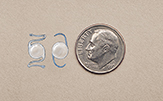Once your old cloudy lens has been removed, your surgeon slips the new clear lens (IOL or intraocular lens) in through the incision. The IOL is then placed in the capsule that held your old lens. With the new lens in place, your surgeon is ready to close the incision. Some incisions may be closed with stitches. Others are self-sealing. That means they will stay closed on their own without stitches. The IOL does nearly the same thing that your old lens did before it became cloudy. It focuses light, letting you see sharp images and vivid colors. The IOL normally lasts a lifetime.
How small is an IOL?
Featured in



